UCBS7100: Sustainable Finance Report on ESG and Financial Analysis
VerifiedAdded on 2022/08/27
|24
|6133
|26
Report
AI Summary
This report delves into the realm of sustainable finance, examining the integration of Environmental, Social, and Governance (ESG) factors into financial analysis and corporate valuation. It begins with an overview of ESG priorities within the global telecommunications industry, utilizing the Sustainability Accounting Standards Board (SASB) framework for measuring performance. The report analyzes British Telecom's ESG priorities and identifies issues reported by nonprofit stakeholders. It further explores the financial modeling of a Green Real Estate Investment Trust (REIT) and analyzes the financial performance of Asian impact investing funds, including Lotus impact. The report emphasizes the importance of integrating ESG criteria into financial models, addressing misconceptions among investors, and highlighting the impact of ESG factors on financial performance. It provides recommendations for decision-making based on available data, including the efficient collection of ESG data and the importance of transparent reporting aligned with capital market requirements. The report also includes a discussion on how ESG factors can influence a company's long-term financial performance and valuation, and the reasons why ESG factors are not always fully considered in financial valuation models.

Running head: SUSTAINABLE FINANCE
Sustainable Finance
Name of the University
Name of the student
Authors note
Sustainable Finance
Name of the University
Name of the student
Authors note
Paraphrase This Document
Need a fresh take? Get an instant paraphrase of this document with our AI Paraphraser
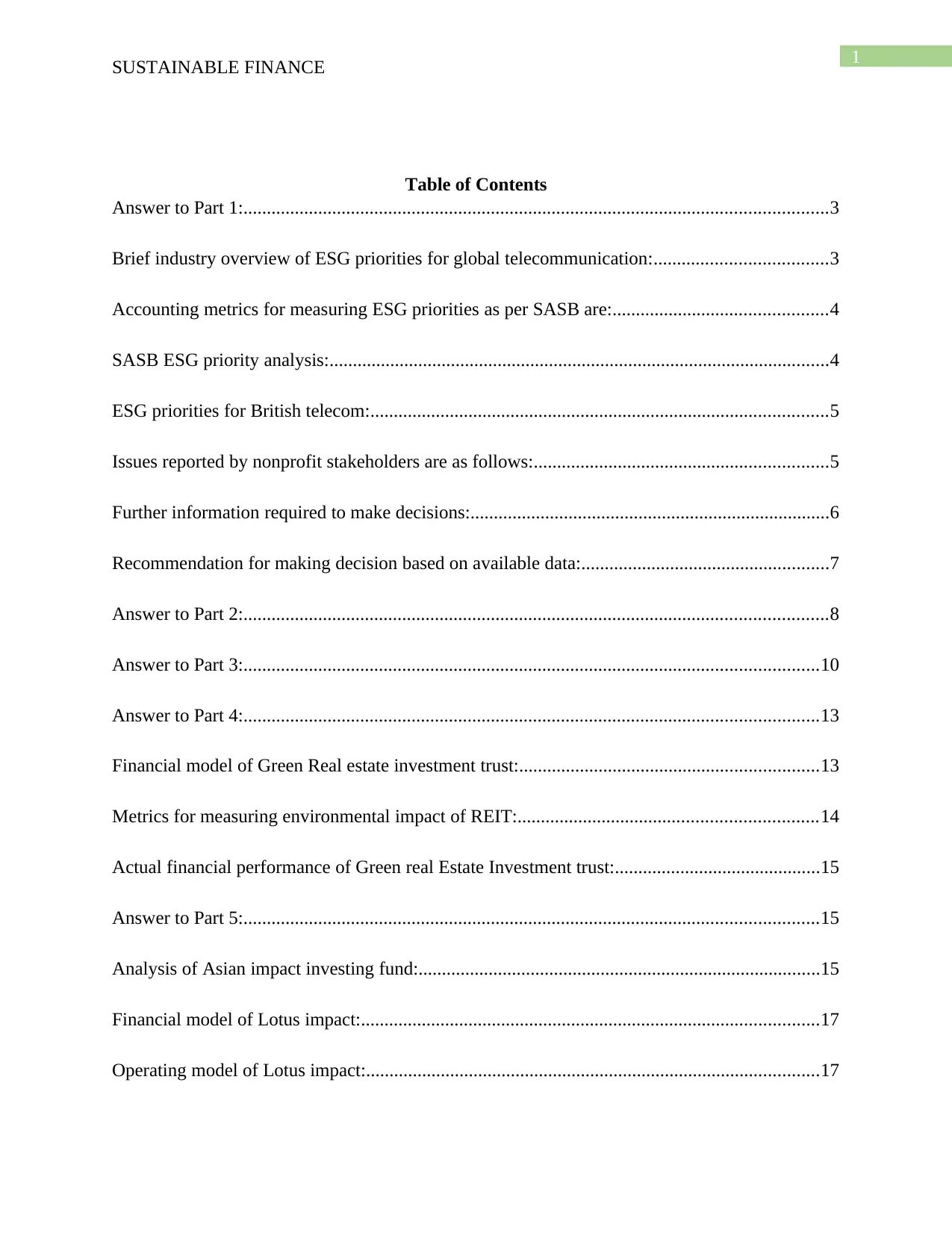
1
SUSTAINABLE FINANCE
Table of Contents
Answer to Part 1:.............................................................................................................................3
Brief industry overview of ESG priorities for global telecommunication:.....................................3
Accounting metrics for measuring ESG priorities as per SASB are:..............................................4
SASB ESG priority analysis:...........................................................................................................4
ESG priorities for British telecom:..................................................................................................5
Issues reported by nonprofit stakeholders are as follows:...............................................................5
Further information required to make decisions:.............................................................................6
Recommendation for making decision based on available data:.....................................................7
Answer to Part 2:.............................................................................................................................8
Answer to Part 3:...........................................................................................................................10
Answer to Part 4:...........................................................................................................................13
Financial model of Green Real estate investment trust:................................................................13
Metrics for measuring environmental impact of REIT:................................................................14
Actual financial performance of Green real Estate Investment trust:............................................15
Answer to Part 5:...........................................................................................................................15
Analysis of Asian impact investing fund:......................................................................................15
Financial model of Lotus impact:..................................................................................................17
Operating model of Lotus impact:.................................................................................................17
SUSTAINABLE FINANCE
Table of Contents
Answer to Part 1:.............................................................................................................................3
Brief industry overview of ESG priorities for global telecommunication:.....................................3
Accounting metrics for measuring ESG priorities as per SASB are:..............................................4
SASB ESG priority analysis:...........................................................................................................4
ESG priorities for British telecom:..................................................................................................5
Issues reported by nonprofit stakeholders are as follows:...............................................................5
Further information required to make decisions:.............................................................................6
Recommendation for making decision based on available data:.....................................................7
Answer to Part 2:.............................................................................................................................8
Answer to Part 3:...........................................................................................................................10
Answer to Part 4:...........................................................................................................................13
Financial model of Green Real estate investment trust:................................................................13
Metrics for measuring environmental impact of REIT:................................................................14
Actual financial performance of Green real Estate Investment trust:............................................15
Answer to Part 5:...........................................................................................................................15
Analysis of Asian impact investing fund:......................................................................................15
Financial model of Lotus impact:..................................................................................................17
Operating model of Lotus impact:.................................................................................................17

2
SUSTAINABLE FINANCE
Metrics for measuring environmental and social impact:..............................................................18
Financial performance of Lotus funds:..........................................................................................18
Reference:......................................................................................................................................19
SUSTAINABLE FINANCE
Metrics for measuring environmental and social impact:..............................................................18
Financial performance of Lotus funds:..........................................................................................18
Reference:......................................................................................................................................19
⊘ This is a preview!⊘
Do you want full access?
Subscribe today to unlock all pages.

Trusted by 1+ million students worldwide
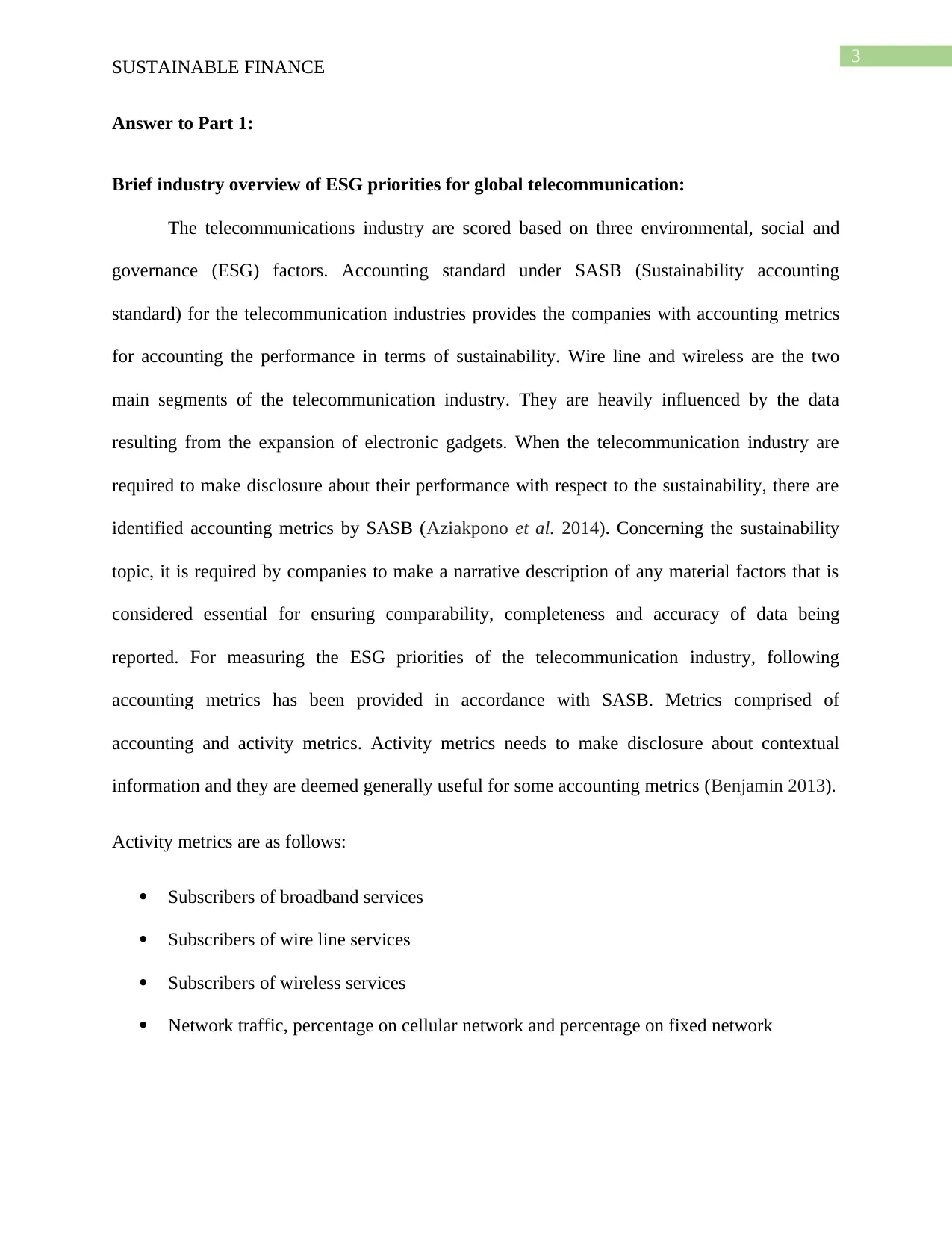
3
SUSTAINABLE FINANCE
Answer to Part 1:
Brief industry overview of ESG priorities for global telecommunication:
The telecommunications industry are scored based on three environmental, social and
governance (ESG) factors. Accounting standard under SASB (Sustainability accounting
standard) for the telecommunication industries provides the companies with accounting metrics
for accounting the performance in terms of sustainability. Wire line and wireless are the two
main segments of the telecommunication industry. They are heavily influenced by the data
resulting from the expansion of electronic gadgets. When the telecommunication industry are
required to make disclosure about their performance with respect to the sustainability, there are
identified accounting metrics by SASB (Aziakpono et al. 2014). Concerning the sustainability
topic, it is required by companies to make a narrative description of any material factors that is
considered essential for ensuring comparability, completeness and accuracy of data being
reported. For measuring the ESG priorities of the telecommunication industry, following
accounting metrics has been provided in accordance with SASB. Metrics comprised of
accounting and activity metrics. Activity metrics needs to make disclosure about contextual
information and they are deemed generally useful for some accounting metrics (Benjamin 2013).
Activity metrics are as follows:
Subscribers of broadband services
Subscribers of wire line services
Subscribers of wireless services
Network traffic, percentage on cellular network and percentage on fixed network
SUSTAINABLE FINANCE
Answer to Part 1:
Brief industry overview of ESG priorities for global telecommunication:
The telecommunications industry are scored based on three environmental, social and
governance (ESG) factors. Accounting standard under SASB (Sustainability accounting
standard) for the telecommunication industries provides the companies with accounting metrics
for accounting the performance in terms of sustainability. Wire line and wireless are the two
main segments of the telecommunication industry. They are heavily influenced by the data
resulting from the expansion of electronic gadgets. When the telecommunication industry are
required to make disclosure about their performance with respect to the sustainability, there are
identified accounting metrics by SASB (Aziakpono et al. 2014). Concerning the sustainability
topic, it is required by companies to make a narrative description of any material factors that is
considered essential for ensuring comparability, completeness and accuracy of data being
reported. For measuring the ESG priorities of the telecommunication industry, following
accounting metrics has been provided in accordance with SASB. Metrics comprised of
accounting and activity metrics. Activity metrics needs to make disclosure about contextual
information and they are deemed generally useful for some accounting metrics (Benjamin 2013).
Activity metrics are as follows:
Subscribers of broadband services
Subscribers of wire line services
Subscribers of wireless services
Network traffic, percentage on cellular network and percentage on fixed network
Paraphrase This Document
Need a fresh take? Get an instant paraphrase of this document with our AI Paraphraser
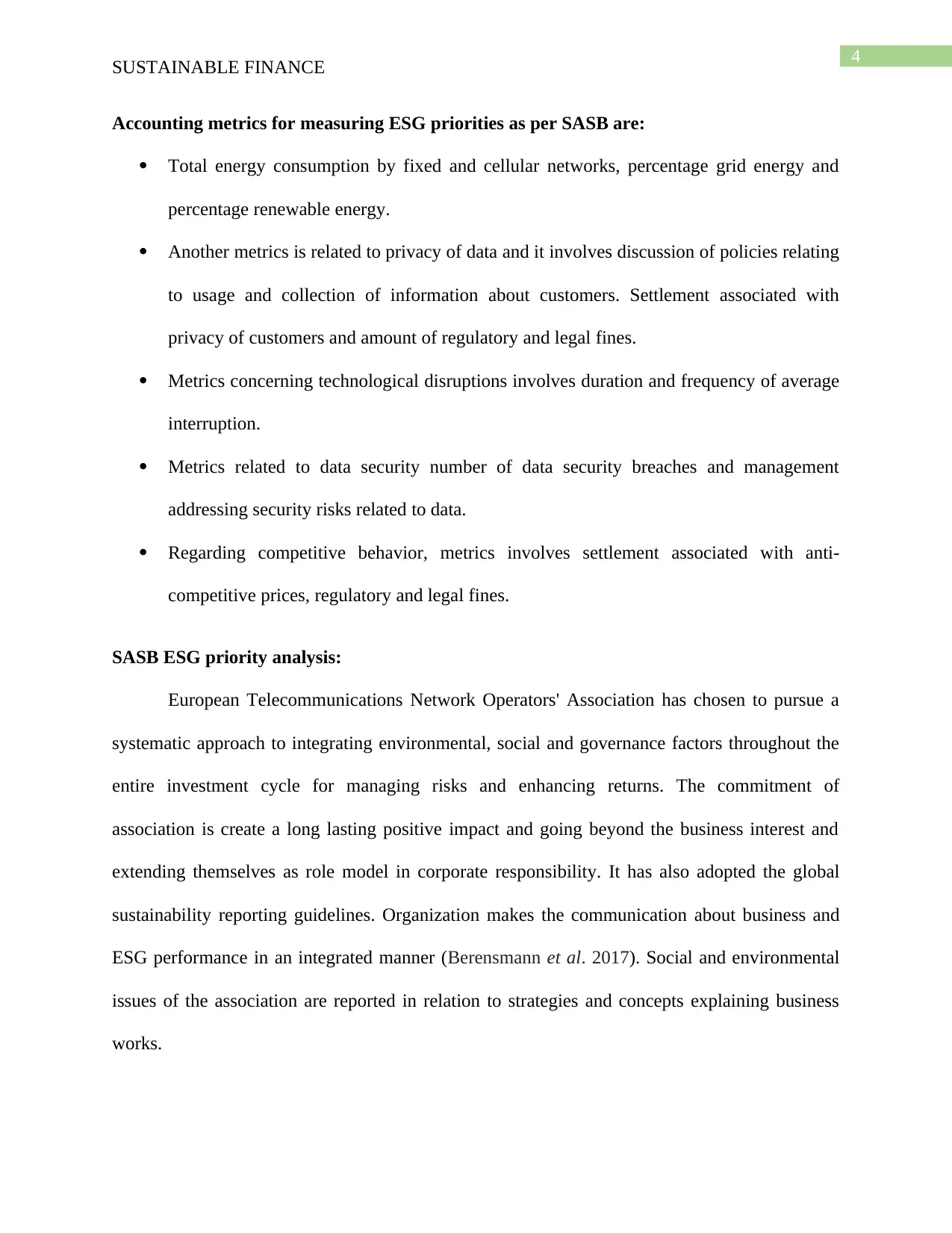
4
SUSTAINABLE FINANCE
Accounting metrics for measuring ESG priorities as per SASB are:
Total energy consumption by fixed and cellular networks, percentage grid energy and
percentage renewable energy.
Another metrics is related to privacy of data and it involves discussion of policies relating
to usage and collection of information about customers. Settlement associated with
privacy of customers and amount of regulatory and legal fines.
Metrics concerning technological disruptions involves duration and frequency of average
interruption.
Metrics related to data security number of data security breaches and management
addressing security risks related to data.
Regarding competitive behavior, metrics involves settlement associated with anti-
competitive prices, regulatory and legal fines.
SASB ESG priority analysis:
European Telecommunications Network Operators' Association has chosen to pursue a
systematic approach to integrating environmental, social and governance factors throughout the
entire investment cycle for managing risks and enhancing returns. The commitment of
association is create a long lasting positive impact and going beyond the business interest and
extending themselves as role model in corporate responsibility. It has also adopted the global
sustainability reporting guidelines. Organization makes the communication about business and
ESG performance in an integrated manner (Berensmann et al. 2017). Social and environmental
issues of the association are reported in relation to strategies and concepts explaining business
works.
SUSTAINABLE FINANCE
Accounting metrics for measuring ESG priorities as per SASB are:
Total energy consumption by fixed and cellular networks, percentage grid energy and
percentage renewable energy.
Another metrics is related to privacy of data and it involves discussion of policies relating
to usage and collection of information about customers. Settlement associated with
privacy of customers and amount of regulatory and legal fines.
Metrics concerning technological disruptions involves duration and frequency of average
interruption.
Metrics related to data security number of data security breaches and management
addressing security risks related to data.
Regarding competitive behavior, metrics involves settlement associated with anti-
competitive prices, regulatory and legal fines.
SASB ESG priority analysis:
European Telecommunications Network Operators' Association has chosen to pursue a
systematic approach to integrating environmental, social and governance factors throughout the
entire investment cycle for managing risks and enhancing returns. The commitment of
association is create a long lasting positive impact and going beyond the business interest and
extending themselves as role model in corporate responsibility. It has also adopted the global
sustainability reporting guidelines. Organization makes the communication about business and
ESG performance in an integrated manner (Berensmann et al. 2017). Social and environmental
issues of the association are reported in relation to strategies and concepts explaining business
works.
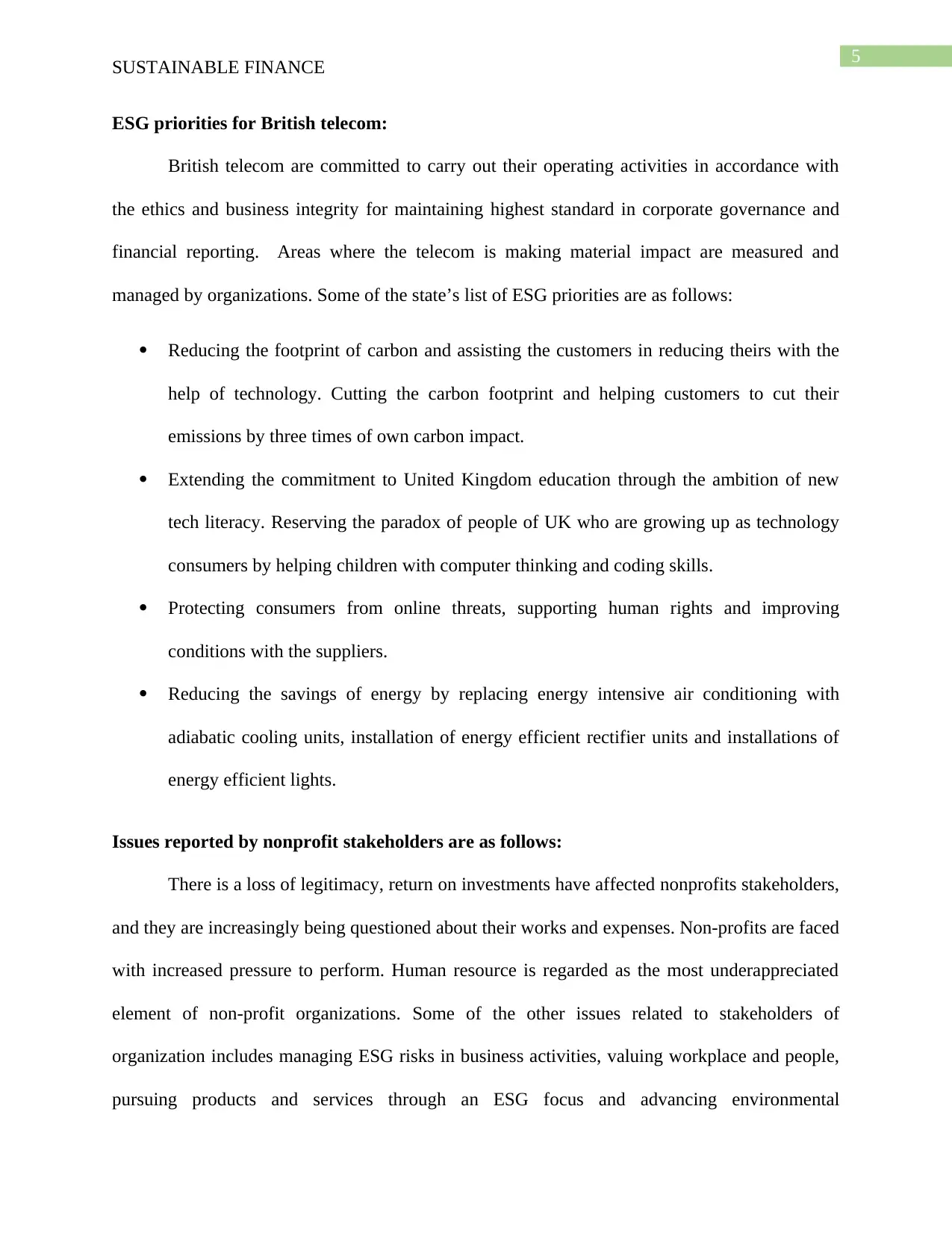
5
SUSTAINABLE FINANCE
ESG priorities for British telecom:
British telecom are committed to carry out their operating activities in accordance with
the ethics and business integrity for maintaining highest standard in corporate governance and
financial reporting. Areas where the telecom is making material impact are measured and
managed by organizations. Some of the state’s list of ESG priorities are as follows:
Reducing the footprint of carbon and assisting the customers in reducing theirs with the
help of technology. Cutting the carbon footprint and helping customers to cut their
emissions by three times of own carbon impact.
Extending the commitment to United Kingdom education through the ambition of new
tech literacy. Reserving the paradox of people of UK who are growing up as technology
consumers by helping children with computer thinking and coding skills.
Protecting consumers from online threats, supporting human rights and improving
conditions with the suppliers.
Reducing the savings of energy by replacing energy intensive air conditioning with
adiabatic cooling units, installation of energy efficient rectifier units and installations of
energy efficient lights.
Issues reported by nonprofit stakeholders are as follows:
There is a loss of legitimacy, return on investments have affected nonprofits stakeholders,
and they are increasingly being questioned about their works and expenses. Non-profits are faced
with increased pressure to perform. Human resource is regarded as the most underappreciated
element of non-profit organizations. Some of the other issues related to stakeholders of
organization includes managing ESG risks in business activities, valuing workplace and people,
pursuing products and services through an ESG focus and advancing environmental
SUSTAINABLE FINANCE
ESG priorities for British telecom:
British telecom are committed to carry out their operating activities in accordance with
the ethics and business integrity for maintaining highest standard in corporate governance and
financial reporting. Areas where the telecom is making material impact are measured and
managed by organizations. Some of the state’s list of ESG priorities are as follows:
Reducing the footprint of carbon and assisting the customers in reducing theirs with the
help of technology. Cutting the carbon footprint and helping customers to cut their
emissions by three times of own carbon impact.
Extending the commitment to United Kingdom education through the ambition of new
tech literacy. Reserving the paradox of people of UK who are growing up as technology
consumers by helping children with computer thinking and coding skills.
Protecting consumers from online threats, supporting human rights and improving
conditions with the suppliers.
Reducing the savings of energy by replacing energy intensive air conditioning with
adiabatic cooling units, installation of energy efficient rectifier units and installations of
energy efficient lights.
Issues reported by nonprofit stakeholders are as follows:
There is a loss of legitimacy, return on investments have affected nonprofits stakeholders,
and they are increasingly being questioned about their works and expenses. Non-profits are faced
with increased pressure to perform. Human resource is regarded as the most underappreciated
element of non-profit organizations. Some of the other issues related to stakeholders of
organization includes managing ESG risks in business activities, valuing workplace and people,
pursuing products and services through an ESG focus and advancing environmental
⊘ This is a preview!⊘
Do you want full access?
Subscribe today to unlock all pages.

Trusted by 1+ million students worldwide
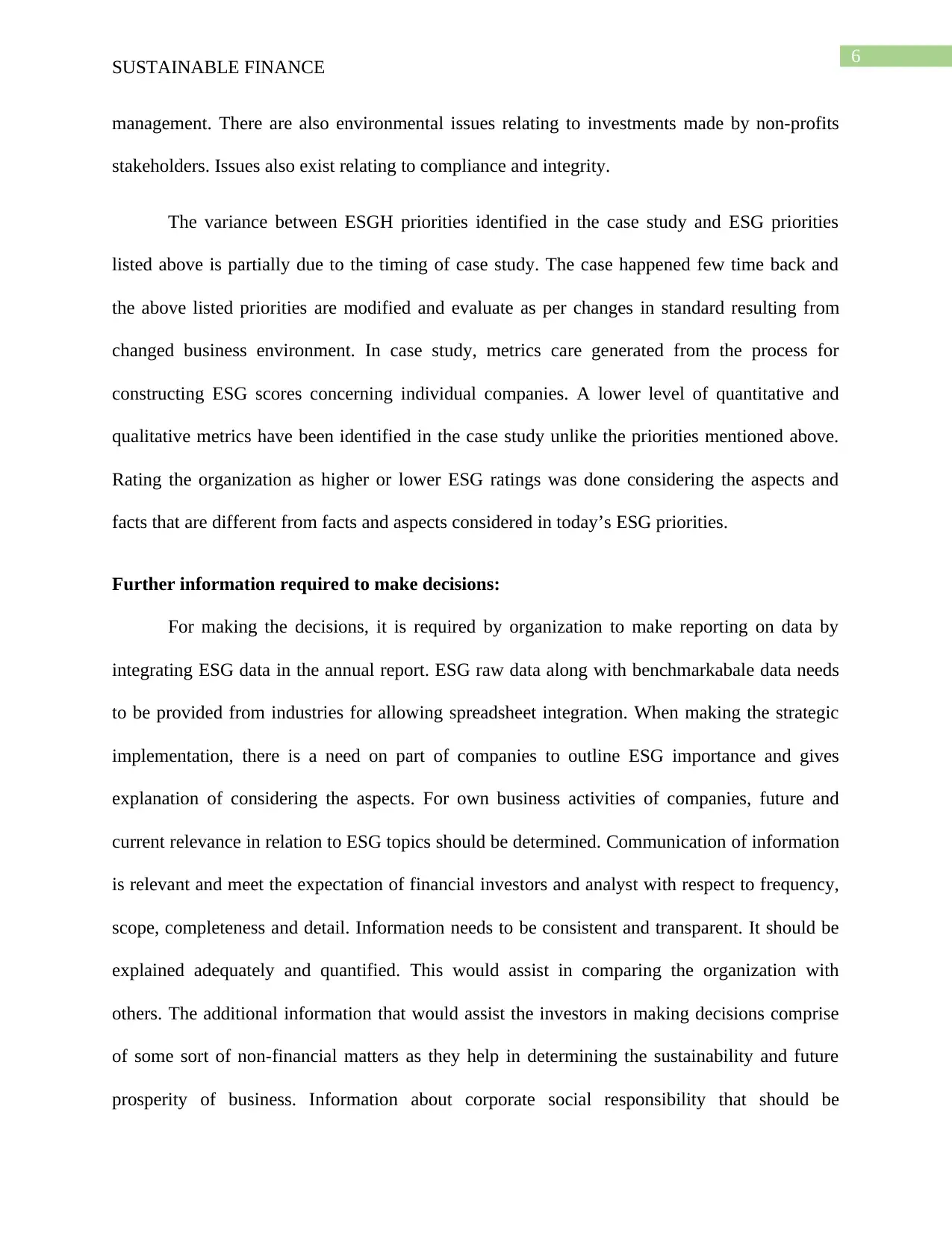
6
SUSTAINABLE FINANCE
management. There are also environmental issues relating to investments made by non-profits
stakeholders. Issues also exist relating to compliance and integrity.
The variance between ESGH priorities identified in the case study and ESG priorities
listed above is partially due to the timing of case study. The case happened few time back and
the above listed priorities are modified and evaluate as per changes in standard resulting from
changed business environment. In case study, metrics care generated from the process for
constructing ESG scores concerning individual companies. A lower level of quantitative and
qualitative metrics have been identified in the case study unlike the priorities mentioned above.
Rating the organization as higher or lower ESG ratings was done considering the aspects and
facts that are different from facts and aspects considered in today’s ESG priorities.
Further information required to make decisions:
For making the decisions, it is required by organization to make reporting on data by
integrating ESG data in the annual report. ESG raw data along with benchmarkabale data needs
to be provided from industries for allowing spreadsheet integration. When making the strategic
implementation, there is a need on part of companies to outline ESG importance and gives
explanation of considering the aspects. For own business activities of companies, future and
current relevance in relation to ESG topics should be determined. Communication of information
is relevant and meet the expectation of financial investors and analyst with respect to frequency,
scope, completeness and detail. Information needs to be consistent and transparent. It should be
explained adequately and quantified. This would assist in comparing the organization with
others. The additional information that would assist the investors in making decisions comprise
of some sort of non-financial matters as they help in determining the sustainability and future
prosperity of business. Information about corporate social responsibility that should be
SUSTAINABLE FINANCE
management. There are also environmental issues relating to investments made by non-profits
stakeholders. Issues also exist relating to compliance and integrity.
The variance between ESGH priorities identified in the case study and ESG priorities
listed above is partially due to the timing of case study. The case happened few time back and
the above listed priorities are modified and evaluate as per changes in standard resulting from
changed business environment. In case study, metrics care generated from the process for
constructing ESG scores concerning individual companies. A lower level of quantitative and
qualitative metrics have been identified in the case study unlike the priorities mentioned above.
Rating the organization as higher or lower ESG ratings was done considering the aspects and
facts that are different from facts and aspects considered in today’s ESG priorities.
Further information required to make decisions:
For making the decisions, it is required by organization to make reporting on data by
integrating ESG data in the annual report. ESG raw data along with benchmarkabale data needs
to be provided from industries for allowing spreadsheet integration. When making the strategic
implementation, there is a need on part of companies to outline ESG importance and gives
explanation of considering the aspects. For own business activities of companies, future and
current relevance in relation to ESG topics should be determined. Communication of information
is relevant and meet the expectation of financial investors and analyst with respect to frequency,
scope, completeness and detail. Information needs to be consistent and transparent. It should be
explained adequately and quantified. This would assist in comparing the organization with
others. The additional information that would assist the investors in making decisions comprise
of some sort of non-financial matters as they help in determining the sustainability and future
prosperity of business. Information about corporate social responsibility that should be
Paraphrase This Document
Need a fresh take? Get an instant paraphrase of this document with our AI Paraphraser
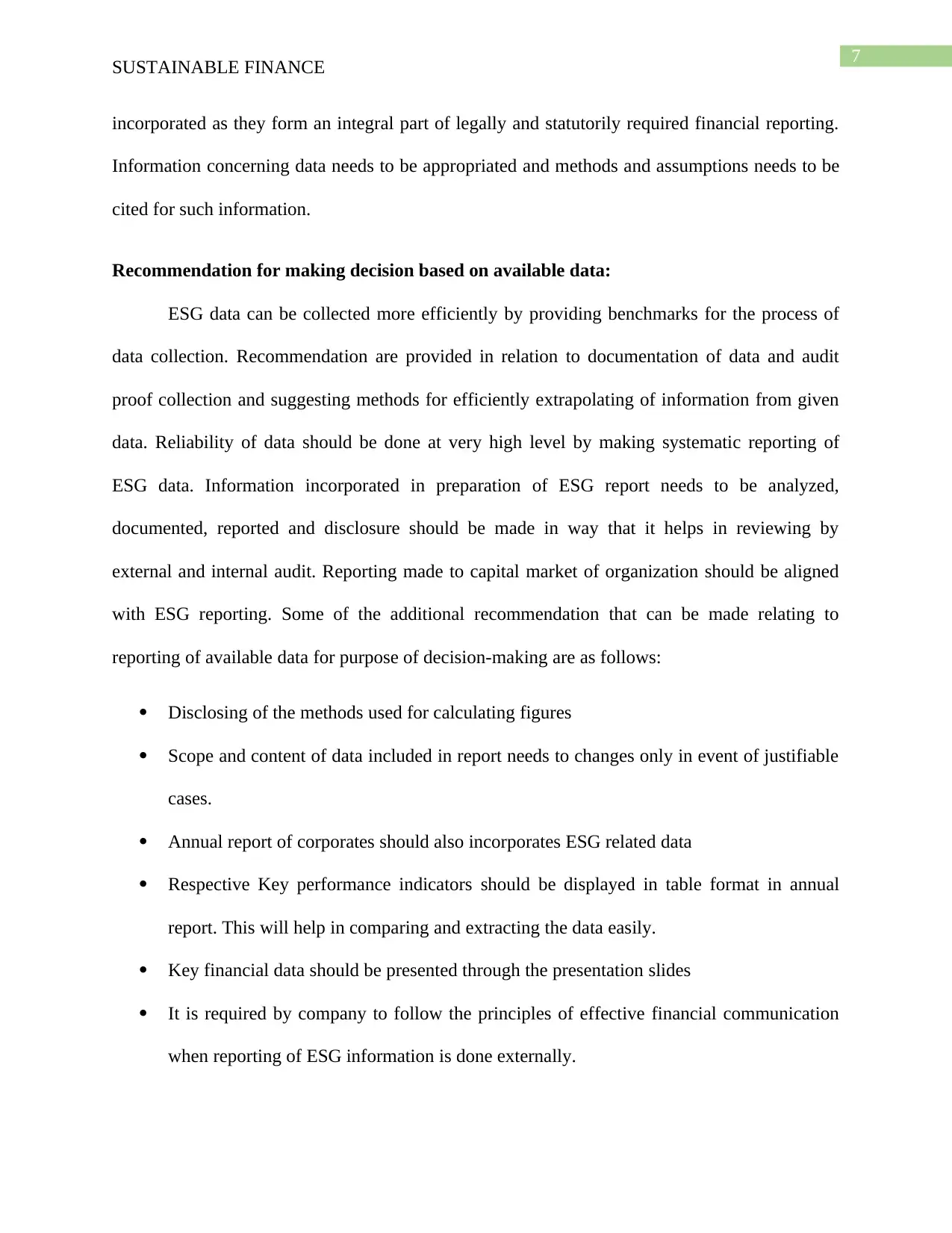
7
SUSTAINABLE FINANCE
incorporated as they form an integral part of legally and statutorily required financial reporting.
Information concerning data needs to be appropriated and methods and assumptions needs to be
cited for such information.
Recommendation for making decision based on available data:
ESG data can be collected more efficiently by providing benchmarks for the process of
data collection. Recommendation are provided in relation to documentation of data and audit
proof collection and suggesting methods for efficiently extrapolating of information from given
data. Reliability of data should be done at very high level by making systematic reporting of
ESG data. Information incorporated in preparation of ESG report needs to be analyzed,
documented, reported and disclosure should be made in way that it helps in reviewing by
external and internal audit. Reporting made to capital market of organization should be aligned
with ESG reporting. Some of the additional recommendation that can be made relating to
reporting of available data for purpose of decision-making are as follows:
Disclosing of the methods used for calculating figures
Scope and content of data included in report needs to changes only in event of justifiable
cases.
Annual report of corporates should also incorporates ESG related data
Respective Key performance indicators should be displayed in table format in annual
report. This will help in comparing and extracting the data easily.
Key financial data should be presented through the presentation slides
It is required by company to follow the principles of effective financial communication
when reporting of ESG information is done externally.
SUSTAINABLE FINANCE
incorporated as they form an integral part of legally and statutorily required financial reporting.
Information concerning data needs to be appropriated and methods and assumptions needs to be
cited for such information.
Recommendation for making decision based on available data:
ESG data can be collected more efficiently by providing benchmarks for the process of
data collection. Recommendation are provided in relation to documentation of data and audit
proof collection and suggesting methods for efficiently extrapolating of information from given
data. Reliability of data should be done at very high level by making systematic reporting of
ESG data. Information incorporated in preparation of ESG report needs to be analyzed,
documented, reported and disclosure should be made in way that it helps in reviewing by
external and internal audit. Reporting made to capital market of organization should be aligned
with ESG reporting. Some of the additional recommendation that can be made relating to
reporting of available data for purpose of decision-making are as follows:
Disclosing of the methods used for calculating figures
Scope and content of data included in report needs to changes only in event of justifiable
cases.
Annual report of corporates should also incorporates ESG related data
Respective Key performance indicators should be displayed in table format in annual
report. This will help in comparing and extracting the data easily.
Key financial data should be presented through the presentation slides
It is required by company to follow the principles of effective financial communication
when reporting of ESG information is done externally.
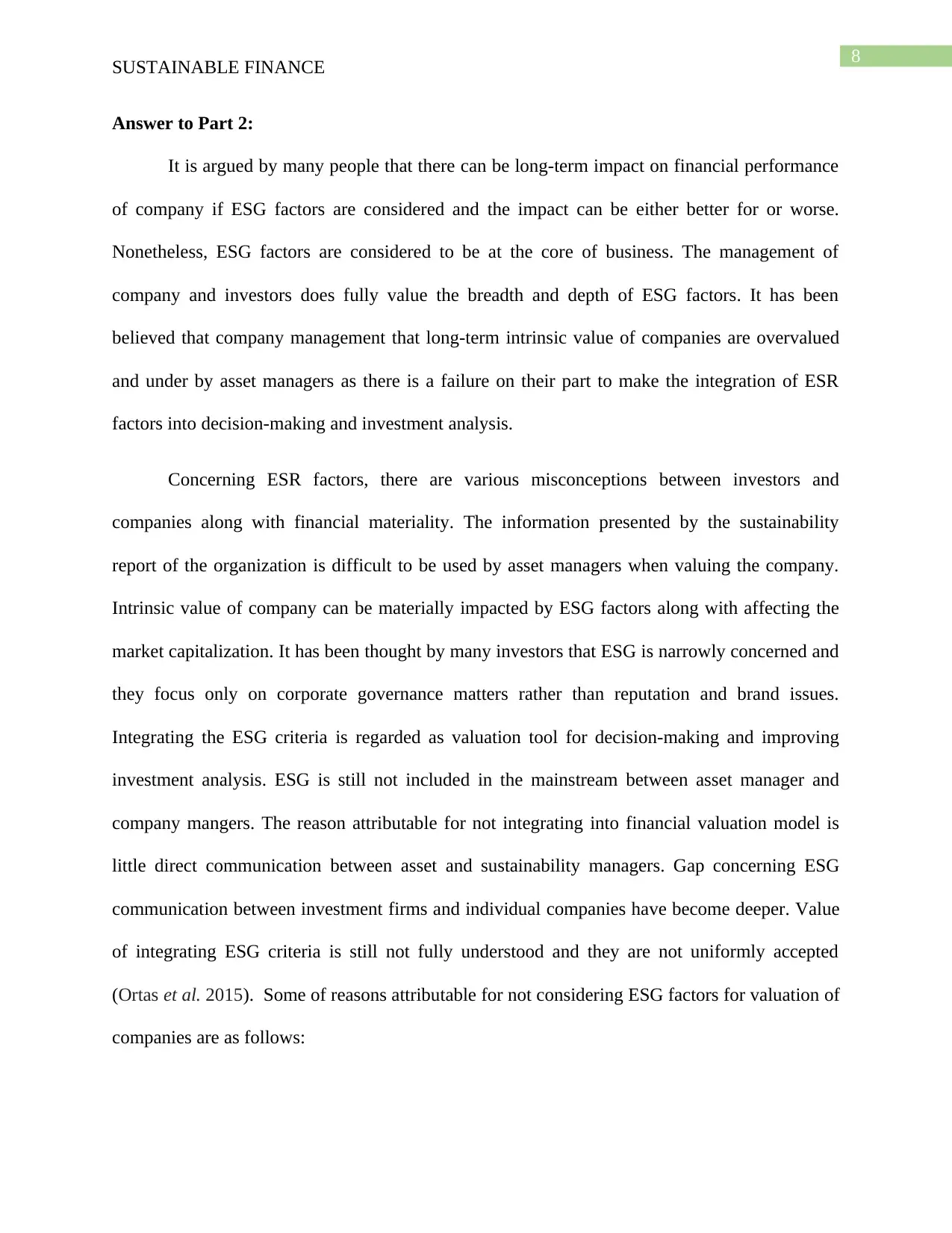
8
SUSTAINABLE FINANCE
Answer to Part 2:
It is argued by many people that there can be long-term impact on financial performance
of company if ESG factors are considered and the impact can be either better for or worse.
Nonetheless, ESG factors are considered to be at the core of business. The management of
company and investors does fully value the breadth and depth of ESG factors. It has been
believed that company management that long-term intrinsic value of companies are overvalued
and under by asset managers as there is a failure on their part to make the integration of ESR
factors into decision-making and investment analysis.
Concerning ESR factors, there are various misconceptions between investors and
companies along with financial materiality. The information presented by the sustainability
report of the organization is difficult to be used by asset managers when valuing the company.
Intrinsic value of company can be materially impacted by ESG factors along with affecting the
market capitalization. It has been thought by many investors that ESG is narrowly concerned and
they focus only on corporate governance matters rather than reputation and brand issues.
Integrating the ESG criteria is regarded as valuation tool for decision-making and improving
investment analysis. ESG is still not included in the mainstream between asset manager and
company mangers. The reason attributable for not integrating into financial valuation model is
little direct communication between asset and sustainability managers. Gap concerning ESG
communication between investment firms and individual companies have become deeper. Value
of integrating ESG criteria is still not fully understood and they are not uniformly accepted
(Ortas et al. 2015). Some of reasons attributable for not considering ESG factors for valuation of
companies are as follows:
SUSTAINABLE FINANCE
Answer to Part 2:
It is argued by many people that there can be long-term impact on financial performance
of company if ESG factors are considered and the impact can be either better for or worse.
Nonetheless, ESG factors are considered to be at the core of business. The management of
company and investors does fully value the breadth and depth of ESG factors. It has been
believed that company management that long-term intrinsic value of companies are overvalued
and under by asset managers as there is a failure on their part to make the integration of ESR
factors into decision-making and investment analysis.
Concerning ESR factors, there are various misconceptions between investors and
companies along with financial materiality. The information presented by the sustainability
report of the organization is difficult to be used by asset managers when valuing the company.
Intrinsic value of company can be materially impacted by ESG factors along with affecting the
market capitalization. It has been thought by many investors that ESG is narrowly concerned and
they focus only on corporate governance matters rather than reputation and brand issues.
Integrating the ESG criteria is regarded as valuation tool for decision-making and improving
investment analysis. ESG is still not included in the mainstream between asset manager and
company mangers. The reason attributable for not integrating into financial valuation model is
little direct communication between asset and sustainability managers. Gap concerning ESG
communication between investment firms and individual companies have become deeper. Value
of integrating ESG criteria is still not fully understood and they are not uniformly accepted
(Ortas et al. 2015). Some of reasons attributable for not considering ESG factors for valuation of
companies are as follows:
⊘ This is a preview!⊘
Do you want full access?
Subscribe today to unlock all pages.

Trusted by 1+ million students worldwide
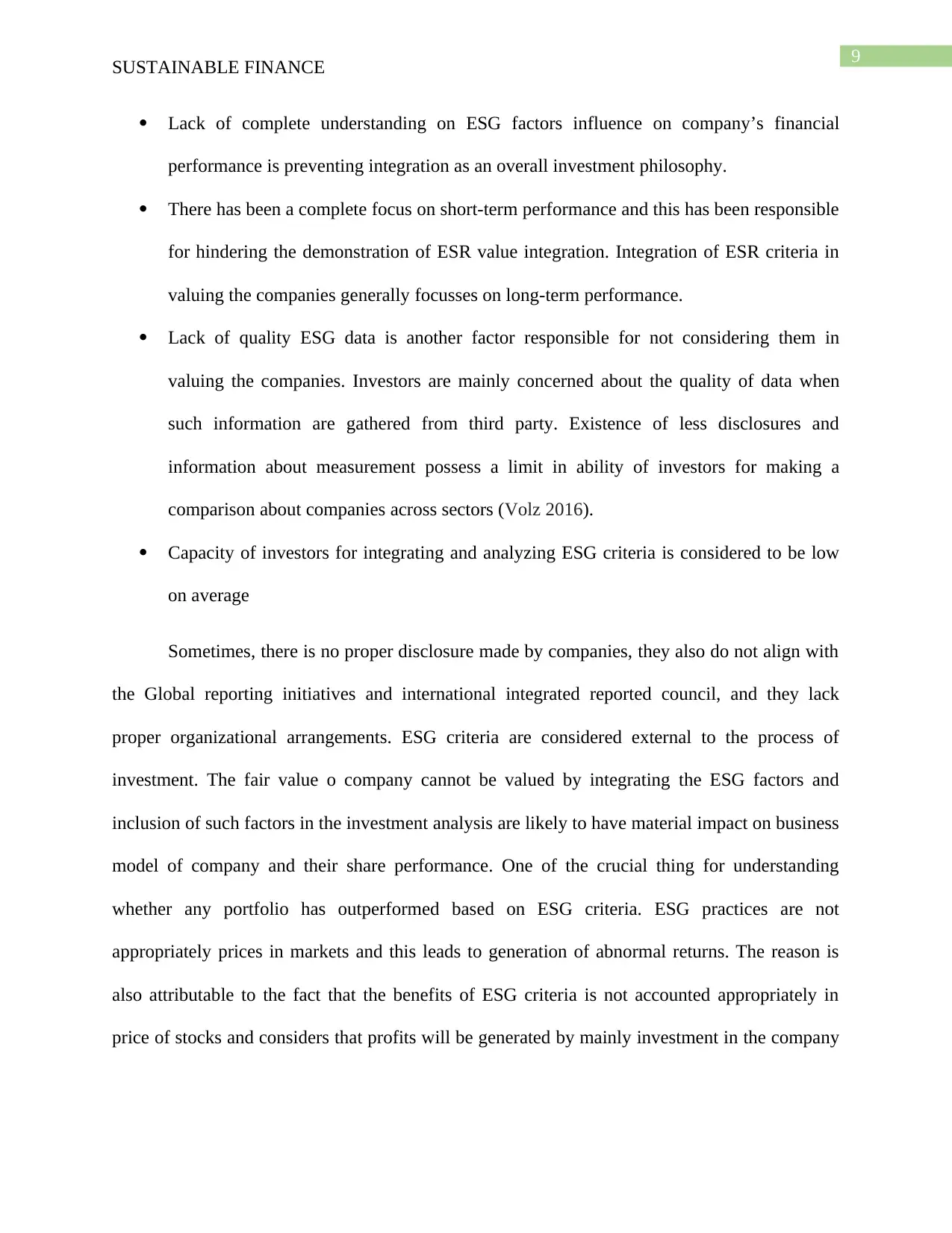
9
SUSTAINABLE FINANCE
Lack of complete understanding on ESG factors influence on company’s financial
performance is preventing integration as an overall investment philosophy.
There has been a complete focus on short-term performance and this has been responsible
for hindering the demonstration of ESR value integration. Integration of ESR criteria in
valuing the companies generally focusses on long-term performance.
Lack of quality ESG data is another factor responsible for not considering them in
valuing the companies. Investors are mainly concerned about the quality of data when
such information are gathered from third party. Existence of less disclosures and
information about measurement possess a limit in ability of investors for making a
comparison about companies across sectors (Volz 2016).
Capacity of investors for integrating and analyzing ESG criteria is considered to be low
on average
Sometimes, there is no proper disclosure made by companies, they also do not align with
the Global reporting initiatives and international integrated reported council, and they lack
proper organizational arrangements. ESG criteria are considered external to the process of
investment. The fair value o company cannot be valued by integrating the ESG factors and
inclusion of such factors in the investment analysis are likely to have material impact on business
model of company and their share performance. One of the crucial thing for understanding
whether any portfolio has outperformed based on ESG criteria. ESG practices are not
appropriately prices in markets and this leads to generation of abnormal returns. The reason is
also attributable to the fact that the benefits of ESG criteria is not accounted appropriately in
price of stocks and considers that profits will be generated by mainly investment in the company
SUSTAINABLE FINANCE
Lack of complete understanding on ESG factors influence on company’s financial
performance is preventing integration as an overall investment philosophy.
There has been a complete focus on short-term performance and this has been responsible
for hindering the demonstration of ESR value integration. Integration of ESR criteria in
valuing the companies generally focusses on long-term performance.
Lack of quality ESG data is another factor responsible for not considering them in
valuing the companies. Investors are mainly concerned about the quality of data when
such information are gathered from third party. Existence of less disclosures and
information about measurement possess a limit in ability of investors for making a
comparison about companies across sectors (Volz 2016).
Capacity of investors for integrating and analyzing ESG criteria is considered to be low
on average
Sometimes, there is no proper disclosure made by companies, they also do not align with
the Global reporting initiatives and international integrated reported council, and they lack
proper organizational arrangements. ESG criteria are considered external to the process of
investment. The fair value o company cannot be valued by integrating the ESG factors and
inclusion of such factors in the investment analysis are likely to have material impact on business
model of company and their share performance. One of the crucial thing for understanding
whether any portfolio has outperformed based on ESG criteria. ESG practices are not
appropriately prices in markets and this leads to generation of abnormal returns. The reason is
also attributable to the fact that the benefits of ESG criteria is not accounted appropriately in
price of stocks and considers that profits will be generated by mainly investment in the company
Paraphrase This Document
Need a fresh take? Get an instant paraphrase of this document with our AI Paraphraser
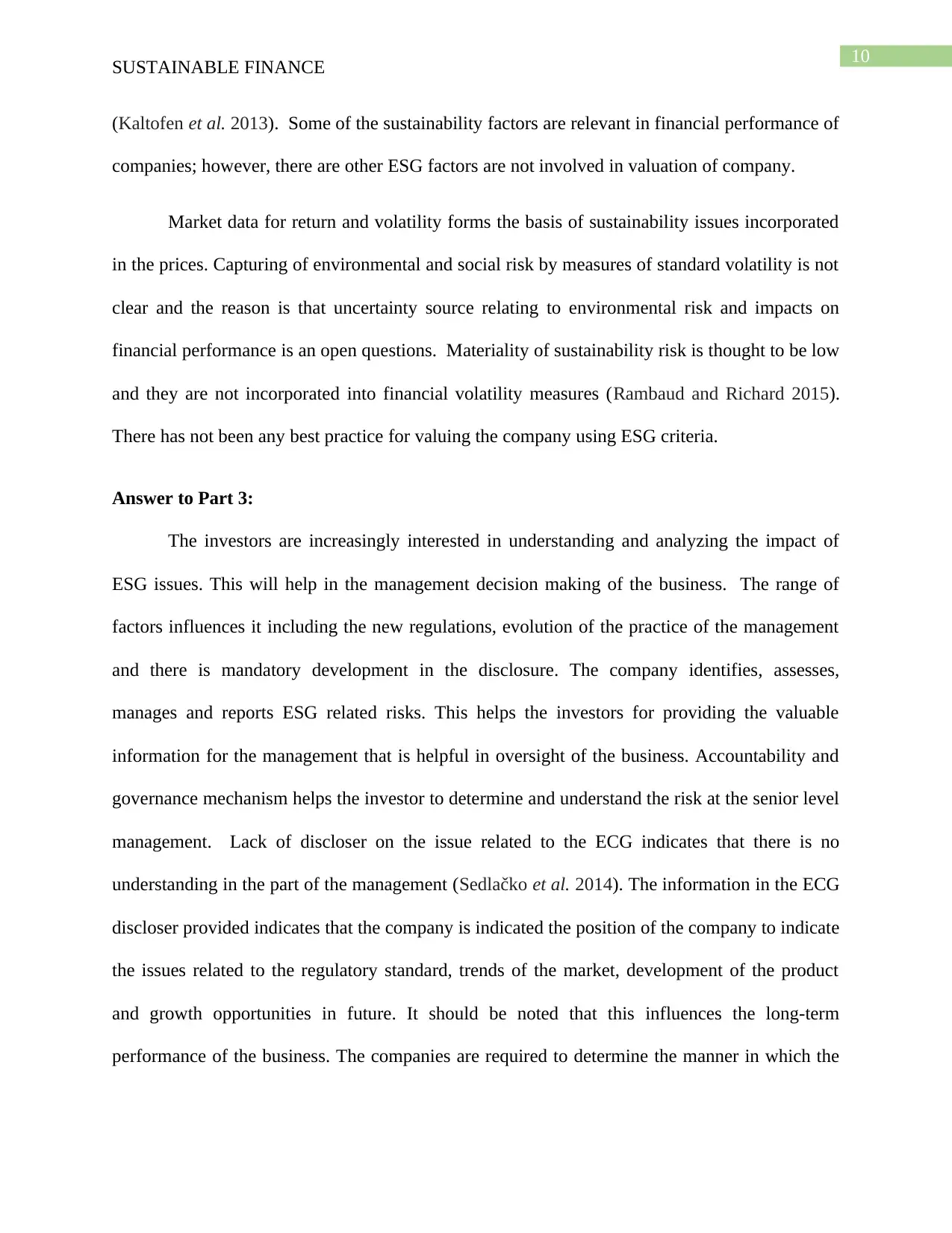
10
SUSTAINABLE FINANCE
(Kaltofen et al. 2013). Some of the sustainability factors are relevant in financial performance of
companies; however, there are other ESG factors are not involved in valuation of company.
Market data for return and volatility forms the basis of sustainability issues incorporated
in the prices. Capturing of environmental and social risk by measures of standard volatility is not
clear and the reason is that uncertainty source relating to environmental risk and impacts on
financial performance is an open questions. Materiality of sustainability risk is thought to be low
and they are not incorporated into financial volatility measures (Rambaud and Richard 2015).
There has not been any best practice for valuing the company using ESG criteria.
Answer to Part 3:
The investors are increasingly interested in understanding and analyzing the impact of
ESG issues. This will help in the management decision making of the business. The range of
factors influences it including the new regulations, evolution of the practice of the management
and there is mandatory development in the disclosure. The company identifies, assesses,
manages and reports ESG related risks. This helps the investors for providing the valuable
information for the management that is helpful in oversight of the business. Accountability and
governance mechanism helps the investor to determine and understand the risk at the senior level
management. Lack of discloser on the issue related to the ECG indicates that there is no
understanding in the part of the management (Sedlačko et al. 2014). The information in the ECG
discloser provided indicates that the company is indicated the position of the company to indicate
the issues related to the regulatory standard, trends of the market, development of the product
and growth opportunities in future. It should be noted that this influences the long-term
performance of the business. The companies are required to determine the manner in which the
SUSTAINABLE FINANCE
(Kaltofen et al. 2013). Some of the sustainability factors are relevant in financial performance of
companies; however, there are other ESG factors are not involved in valuation of company.
Market data for return and volatility forms the basis of sustainability issues incorporated
in the prices. Capturing of environmental and social risk by measures of standard volatility is not
clear and the reason is that uncertainty source relating to environmental risk and impacts on
financial performance is an open questions. Materiality of sustainability risk is thought to be low
and they are not incorporated into financial volatility measures (Rambaud and Richard 2015).
There has not been any best practice for valuing the company using ESG criteria.
Answer to Part 3:
The investors are increasingly interested in understanding and analyzing the impact of
ESG issues. This will help in the management decision making of the business. The range of
factors influences it including the new regulations, evolution of the practice of the management
and there is mandatory development in the disclosure. The company identifies, assesses,
manages and reports ESG related risks. This helps the investors for providing the valuable
information for the management that is helpful in oversight of the business. Accountability and
governance mechanism helps the investor to determine and understand the risk at the senior level
management. Lack of discloser on the issue related to the ECG indicates that there is no
understanding in the part of the management (Sedlačko et al. 2014). The information in the ECG
discloser provided indicates that the company is indicated the position of the company to indicate
the issues related to the regulatory standard, trends of the market, development of the product
and growth opportunities in future. It should be noted that this influences the long-term
performance of the business. The companies are required to determine the manner in which the
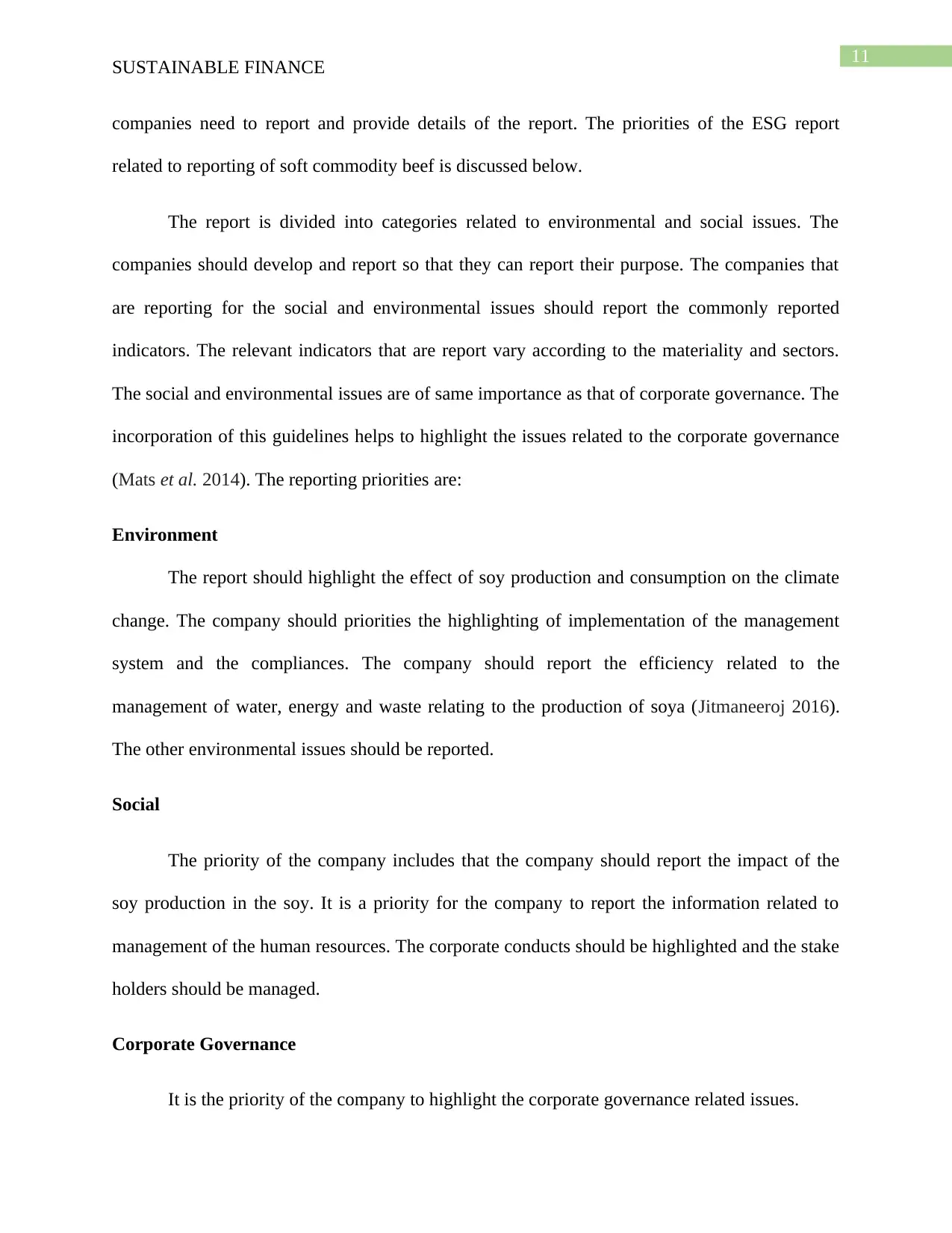
11
SUSTAINABLE FINANCE
companies need to report and provide details of the report. The priorities of the ESG report
related to reporting of soft commodity beef is discussed below.
The report is divided into categories related to environmental and social issues. The
companies should develop and report so that they can report their purpose. The companies that
are reporting for the social and environmental issues should report the commonly reported
indicators. The relevant indicators that are report vary according to the materiality and sectors.
The social and environmental issues are of same importance as that of corporate governance. The
incorporation of this guidelines helps to highlight the issues related to the corporate governance
(Mats et al. 2014). The reporting priorities are:
Environment
The report should highlight the effect of soy production and consumption on the climate
change. The company should priorities the highlighting of implementation of the management
system and the compliances. The company should report the efficiency related to the
management of water, energy and waste relating to the production of soya (Jitmaneeroj 2016).
The other environmental issues should be reported.
Social
The priority of the company includes that the company should report the impact of the
soy production in the soy. It is a priority for the company to report the information related to
management of the human resources. The corporate conducts should be highlighted and the stake
holders should be managed.
Corporate Governance
It is the priority of the company to highlight the corporate governance related issues.
SUSTAINABLE FINANCE
companies need to report and provide details of the report. The priorities of the ESG report
related to reporting of soft commodity beef is discussed below.
The report is divided into categories related to environmental and social issues. The
companies should develop and report so that they can report their purpose. The companies that
are reporting for the social and environmental issues should report the commonly reported
indicators. The relevant indicators that are report vary according to the materiality and sectors.
The social and environmental issues are of same importance as that of corporate governance. The
incorporation of this guidelines helps to highlight the issues related to the corporate governance
(Mats et al. 2014). The reporting priorities are:
Environment
The report should highlight the effect of soy production and consumption on the climate
change. The company should priorities the highlighting of implementation of the management
system and the compliances. The company should report the efficiency related to the
management of water, energy and waste relating to the production of soya (Jitmaneeroj 2016).
The other environmental issues should be reported.
Social
The priority of the company includes that the company should report the impact of the
soy production in the soy. It is a priority for the company to report the information related to
management of the human resources. The corporate conducts should be highlighted and the stake
holders should be managed.
Corporate Governance
It is the priority of the company to highlight the corporate governance related issues.
⊘ This is a preview!⊘
Do you want full access?
Subscribe today to unlock all pages.

Trusted by 1+ million students worldwide
1 out of 24
Your All-in-One AI-Powered Toolkit for Academic Success.
+13062052269
info@desklib.com
Available 24*7 on WhatsApp / Email
![[object Object]](/_next/static/media/star-bottom.7253800d.svg)
Unlock your academic potential
Copyright © 2020–2025 A2Z Services. All Rights Reserved. Developed and managed by ZUCOL.


